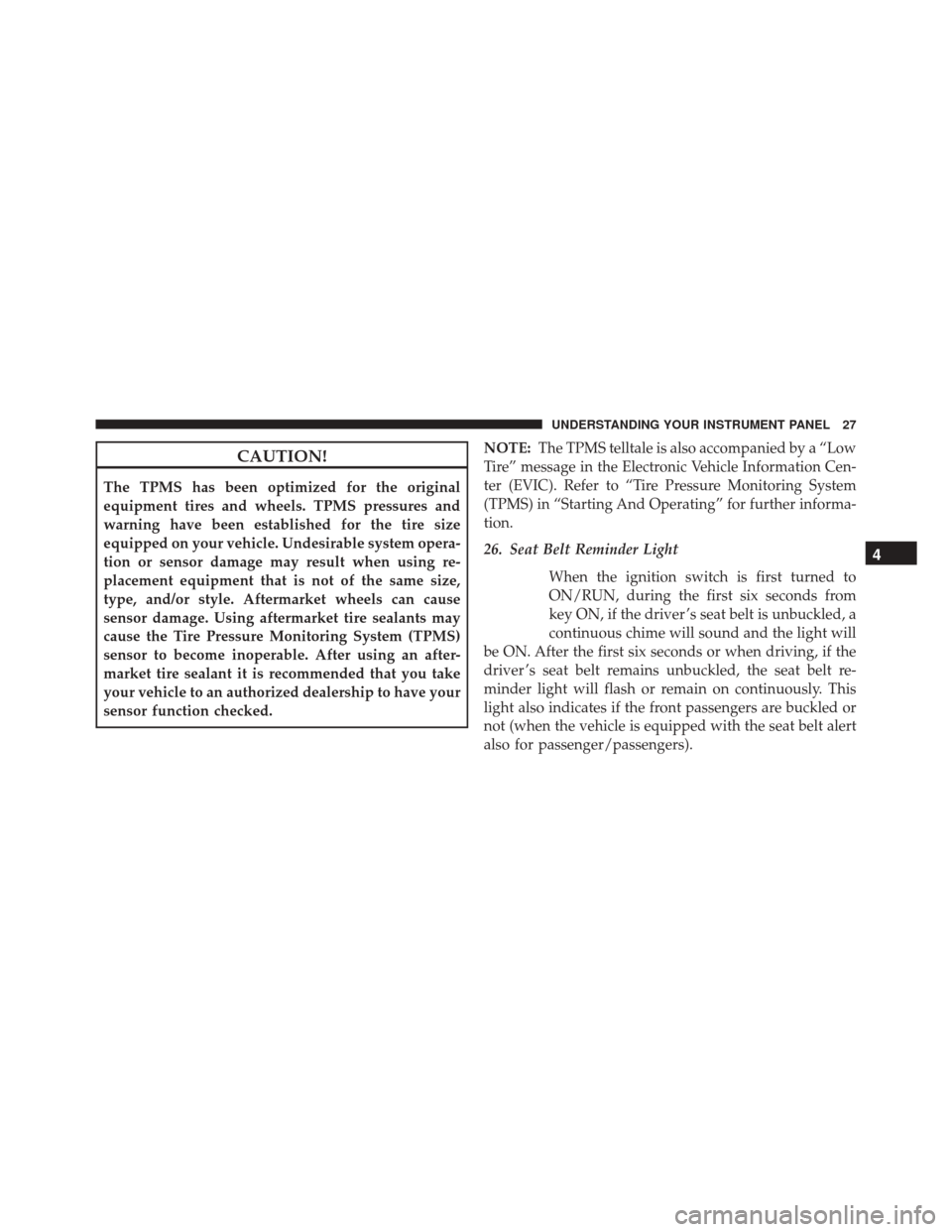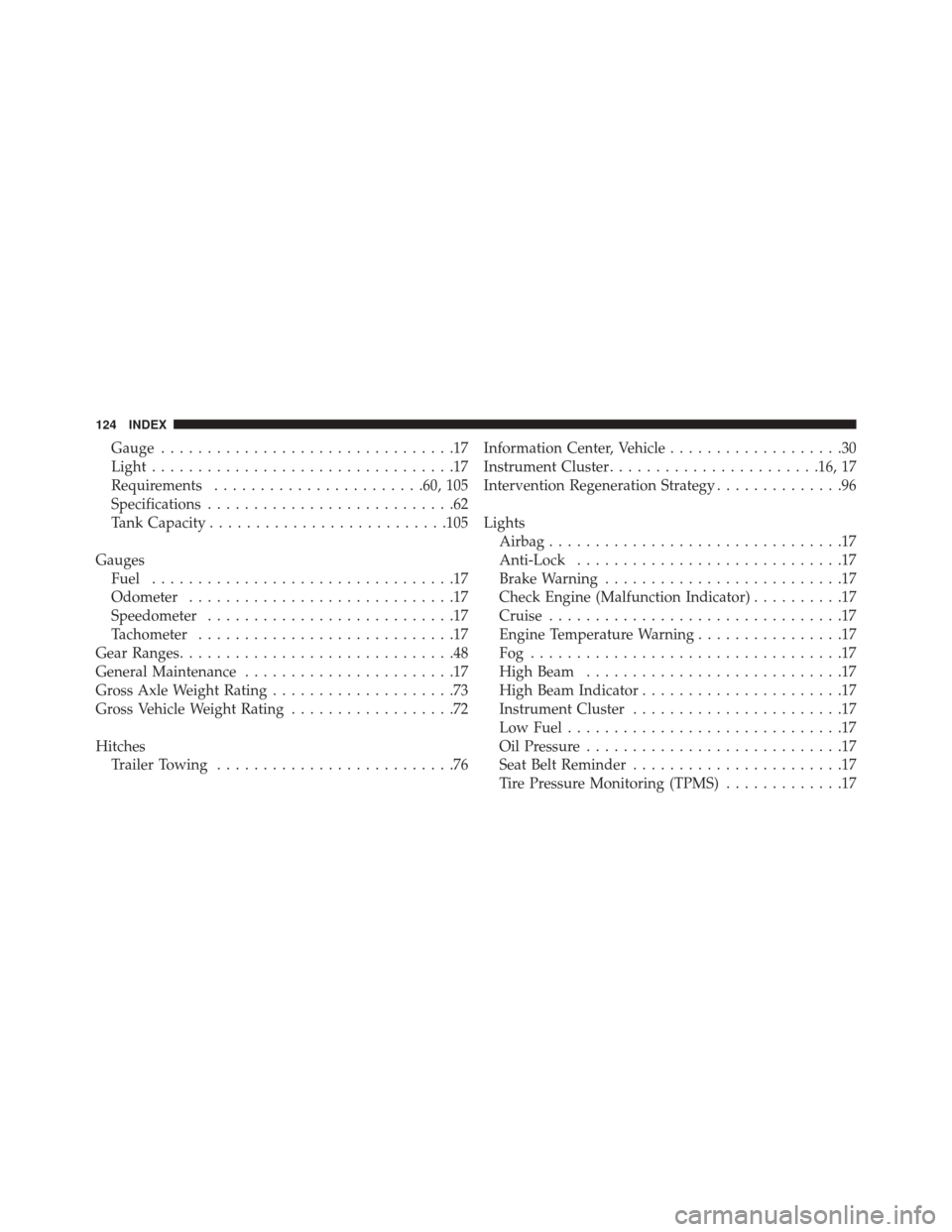tire pressure Ram ProMaster 2015 Diesel Supplement
[x] Cancel search | Manufacturer: RAM, Model Year: 2015, Model line: ProMaster, Model: Ram ProMaster 2015Pages: 130, PDF Size: 0.59 MB
Page 27 of 130

23. Generic Warning LightThe Generic Warning Light will illuminate in
blinking mode if any of the following condi-
tions occur:
• Air Bag Warning Light Fault
• Engine Oil Pressure Sensor Failure
• Parking Sensor Failure
• Water In Fuel Presence
• Fuel Cutoff Intervention
• “Engine Minimum Oil Level”
• “Engine Min Oil Sensor Fail”
• Swivel Seat Malfunction
If the Generic Warning Light is blinking an air bag system
failure may be present, see an authorized dealer as soon
as possible. 24. Air Bag Warning Light
This light will turn on for four to eight seconds
as a bulb check when the ignition switch is first
turned to ON/RUN. If the light is either not on
during starting, stays on, or turns on while
driving, have the system inspected at an authorized
dealer as soon as possible. Refer to “Occupant Restraints”
in “Things To Know Before Starting Your Vehicle” for
further information.
25. Tire Pressure Monitoring Telltale Light
Each tire, including the spare (if provided),
should be checked monthly when cold and
inflated to the inflation pressure recommended
by the vehicle manufacturer on the vehicle
placard or tire inflation pressure label. (If your vehicle
has tires of a different size than the size indicated on the
4
UNDERSTANDING YOUR INSTRUMENT PANEL 25
Page 28 of 130

vehicle placard or tire inflation pressure label, you should
determine the proper tire inflation pressure for those
tires.)
As an added safety feature, your vehicle has been
equipped with a Tire Pressure Monitoring System
(TPMS) that illuminates a low tire pressure telltale when
one or more of your tires is significantly under-inflated.
Accordingly, when the low tire pressure telltale illumi-
nates, you should stop and check your tires as soon as
possible, and inflate them to the proper pressure. Driving
on a significantly under-inflated tire causes the tire to
overheat and can lead to tire failure. Under-inflation also
reduces fuel efficiency and tire tread life, and may affect
the vehicle’s handling and stopping ability.
Please note that the TPMS is not a substitute for proper
tire maintenance, and it is the driver ’s responsibility to
maintain correct tire pressure, even if under-inflation has
not reached the level to trigger illumination of the TPMS
low tire pressure telltale.Your vehicle has also been equipped with a TPMS
malfunction strategy to indicate when the system is not
operating properly. When the system detects a malfunc-
tion, the low tire pressure telltale will flash for approxi-
mately one minute and then remain continuously illumi-
nated. This sequence will continue upon subsequent
vehicle start-ups as long as the malfunction exists. When
the low tire pressure telltale is illuminated, the system
may not be able to detect or signal low tire pressure as
intended. TPMS malfunctions may occur for a variety of
reasons, including the installation of replacement or
alternate tires or wheels on the vehicle that prevent the
TPMS from functioning properly. Always check the
TPMS telltale after replacing one or more tires or wheels
on your vehicle, to ensure that the replacement or alter-
nate tires and wheels allow the TPMS to continue to
function properly.
26 UNDERSTANDING YOUR INSTRUMENT PANEL
Page 29 of 130

CAUTION!
The TPMS has been optimized for the original
equipment tires and wheels. TPMS pressures and
warning have been established for the tire size
equipped on your vehicle. Undesirable system opera-
tion or sensor damage may result when using re-
placement equipment that is not of the same size,
type, and/or style. Aftermarket wheels can cause
sensor damage. Using aftermarket tire sealants may
cause the Tire Pressure Monitoring System (TPMS)
sensor to become inoperable. After using an after-
market tire sealant it is recommended that you take
your vehicle to an authorized dealership to have your
sensor function checked.NOTE:
The TPMS telltale is also accompanied by a “Low
Tire” message in the Electronic Vehicle Information Cen-
ter (EVIC). Refer to “Tire Pressure Monitoring System
(TPMS) in “Starting And Operating” for further informa-
tion.
26. Seat Belt Reminder Light
When the ignition switch is first turned to
ON/RUN, during the first six seconds from
key ON, if the driver ’s seat belt is unbuckled, a
continuous chime will sound and the light will
be ON. After the first six seconds or when driving, if the
driver ’s seat belt remains unbuckled, the seat belt re-
minder light will flash or remain on continuously. This
light also indicates if the front passengers are buckled or
not (when the vehicle is equipped with the seat belt alert
also for passenger/passengers).
4
UNDERSTANDING YOUR INSTRUMENT PANEL 27
Page 82 of 130

WARNING!(Continued)
Total weight must be distributed between the tow
vehicle and the trailer such that the following four
ratings are not exceeded:
1. GVWR
2. GTW
3. GAWR
4. Tongue weight rating for the trailer hitch utilized
Towing Requirements — Tires
• Do not attempt to tow a trailer while using a compact
spare tire.
• Proper tire inflation pressures are essential to the safe
and satisfactory operation of your vehicle. Refer to
“Tires – General Information” in “Starting And Oper-
ating” for proper tire inflation procedures. •
Check the trailer tires for proper tire inflation pres-
sures before trailer usage.
• Check for signs of tire wear or visible tire damage
before towing a trailer. Refer to “Tires – General
Information” in “Starting And Operating” for the
proper inspection procedure.
• When replacing tires, refer to “Tires – General Infor-
mation” in “Starting And Operating” for the proper
tire replacement procedures. Replacing tires with a
higher load carrying capacity will not increase the
vehicle’s GVWR and GAWR limits.Towing Requirements — Trailer Brakes
• Do not interconnect the hydraulic brake system or
vacuum system of your vehicle with that of the trailer.
This could cause inadequate braking and possible
personal injury.
80 STARTING AND OPERATING
Page 100 of 130

spraying water from a garden hose vertically down the
face of the A/C condenser (if equipped) or the back of the
radiator core.
Check the engine cooling system hoses for brittle rubber,
cracking, tears, cuts and tightness of the connection at the
coolant recovery bottle and radiator. Inspect the entire
system for leaks.
With the engine at normal operating temperature (but
not running), check the cooling system pressure cap for
proper vacuum sealing by draining a small amount of
engine coolant (antifreeze) from the radiator drain cock.
The radiator drain cock is located in the lower radiator
tank. If the cap is sealing properly, the engine coolant
(antifreeze) will begin to drain from the coolant expan-
sion bottle. DO NOT REMOVE THE COOLANT PRES-
SURE CAP WHEN THE COOLING SYSTEM IS HOT.Cooling System — Drain Flush And Refill
If the engine coolant (antifreeze) is dirty or contains a
considerable amount of sediment, clean and flush with a
reliable cooling system cleaner. Follow with a thorough
rinsing to remove all deposits and chemicals. Properly
dispose of old engine coolant (antifreeze).
Refer to the “Maintenance Schedule” for the proper
maintenance intervals.
Selection Of Coolant
Refer to “Fluids, Lubricants, And Genuine Parts” in
“Maintaining Your Vehicle” for further information.
98 MAINTAINING YOUR VEHICLE
Page 114 of 130

MAINTENANCE SCHEDULE — DIESEL ENGINE
Your vehicle is equipped with an automatic oil change
indicator system. The oil change indicator system will
remind you that it is time to take your vehicle in for
scheduled maintenance.
Based on engine operation conditions, the oil change
indicator message will illuminate in the instrument clus-
ter. This means that service is required for your vehicle.
Operating conditions such as frequent short-trips, trailer
tow, and extremely hot or cold ambient temperatures will
influence when the “Oil Change Required” message is
displayed. Severe Operating Conditions can cause the
change oil message to illuminate as early as 3,500 miles
(5,600 km) since last reset. Have your vehicle serviced as
soon as possible, within the next 500 miles (805 km).
Your authorized dealer will reset the oil change indicator
message after completing the scheduled oil change. If a
scheduled oil change is performed by someone otherthan your authorized dealer, the message can be reset by
referring to the steps described under “Electronic Vehicle
Information Center (EVIC)” in “Understanding Your
Instrument Panel” for further information.
NOTE:
Under no circumstances should oil change inter-
vals exceed 18,500 miles (29,773 km) or twelve months,
whichever comes first.
Once A Month Or Before A Long Trip:
• Check engine oil level
• Check windshield washer fluid level
• Check the tire inflation pressures and look for unusual
wear or damage
• Check the fluid levels of the coolant reservoir, brake
master cylinder, and power steering and fill as needed
• Check function of all interior and exterior lights
112 MAINTENANCE SCHEDULE
Page 126 of 130

Gauge................................17
Light .................................17
Requirements ...................... .60, 105
Specifications ...........................62
Tank Capacity ......................... .105
Gauges Fuel .................................17
Odometer .............................17
Speedometer ...........................17
Tachometer ............................17
Gear Ranges ..............................48
General Maintenance .......................17
Gross Axle Weight Rating ....................73
Gross Vehicle Weight Rating ..................72
Hitches Trailer Towing ..........................76 Information Center, Vehicle
...................30
Instrument Cluster ...................... .16, 17
Intervention Regeneration Strategy ..............96
Lights Airbag ................................17
Anti-Lock .............................17
Brake Warning ..........................17
Check Engine (Malfunction Indicator) ..........17
Cruise ................................17
Engine Temperature Warning ................17
Fog ..................................17
High Beam ............................17
High Beam Indicator ......................17
Instrument Cluster .......................17
Low Fuel ..............................17
Oil Pressure ............................17
Seat Belt Reminder .......................17
Tire Pressure Monitoring (TPMS) .............17
124 INDEX